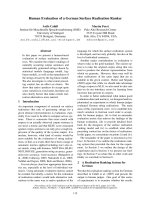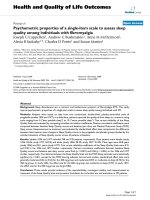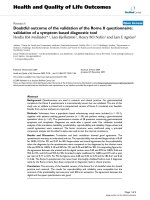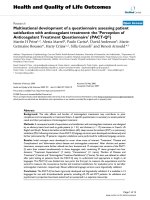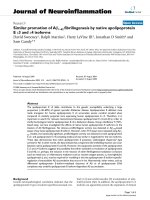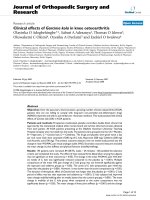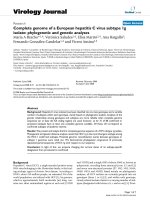báo cáo hóa học: " Doubtful outcome of the validation of the Rome II questionnaire: validation of a symptom based diagnostic tool" doc
Bạn đang xem bản rút gọn của tài liệu. Xem và tải ngay bản đầy đủ của tài liệu tại đây (251.18 KB, 9 trang )
BioMed Central
Page 1 of 9
(page number not for citation purposes)
Health and Quality of Life Outcomes
Open Access
Research
Doubtful outcome of the validation of the Rome II questionnaire:
validation of a symptom based diagnostic tool
Herdis KM Molinder*
1
, Lars Kjellström
2
, Henry BO Nylin
2
and Lars E Agréus
3
Address:
1
Centre for Family and Community Medicine, Karolinska Institutet, Nobels Allé 12, 141 52 Huddinge, Sweden,
2
Department of
Medicine, Huddinge, Karolinska Institutet, Stockholm, Sweden and
3
Centre for Family and Community Medicine. Karolinska Institutet,
Stockholm, Sweden
Email: Herdis KM Molinder* - ; Lars Kjellström - ; Henry BO Nylin - ;
Lars E Agréus -
* Corresponding author
Abstract
Background: Questionnaires are used in research and clinical practice. For gastrointestinal
complaints the Rome II questionnaire is internationally known but not validated. The aim of this
study was to validate a printed and a computerized version of Rome II, translated into Swedish.
Results from various analyses are reported.
Methods: Volunteers from a population based colonoscopy study were included (n = 1011),
together with patients seeking general practice (n = 45) and patients visiting a gastrointestinal
specialists' clinic (n = 67). The questionnaire consists of 38 questions concerning gastrointestinal
symptoms and complaints. Diagnoses are made after a special code. Our validation included
analyses of the translation, feasibility, predictability, reproducibility and reliability. Kappa values and
overall agreement were measured. The factor structures were confirmed using a principal
component analysis and Cronbach's alpha was used to test the internal consistency.
Results and Discussion: Translation and back translation showed good agreement. The
questionnaire was easy to understand and use. The reproducibility test showed kappa values of 0.60
for GERS, 0.52 for FD, and 0.47 for IBS. Kappa values and overall agreement for the predictability
when the diagnoses by the questionnaire were compared to the diagnoses by the clinician were
0.26 and 90% for GERS, 0.18 and 85% for FD, and 0.49 and 86% for IBS. Corresponding figures for
the agreement between the printed and the digital version were 0.50 and 92% for GERS, 0.64 and
95% for FD, and 0.76 and 95% for IBS. Cronbach's alpha coefficient for GERS was 0.75 with a span
per item of 0.71 to 0.76. For FD the figures were 0.68 and 0.54 to 0.70 and for IBS 0.61 and 0.56
to 0.66. The Rome II questionnaire has never been thoroughly validated before even if diagnoses
made by the Rome criteria have been compared to diagnoses made in clinical practice.
Conclusion: The accuracy of the Swedish version of the Rome II is of doubtful value for clinical
practice and research. The results for reproducibility and reliability were acceptable but the
outcome of the predictability test was poor with IBS as an exception. The agreement between the
digital and the paper questionnaire was good.
Published: 29 December 2009
Health and Quality of Life Outcomes 2009, 7:106 doi:10.1186/1477-7525-7-106
Received: 5 March 2009
Accepted: 29 December 2009
This article is available from: />© 2009 Molinder et al; licensee BioMed Central Ltd.
This is an Open Access article distributed under the terms of the Creative Commons Attribution License ( />),
which permits unrestricted use, distribution, and reproduction in any medium, provided the original work is properly cited.
Health and Quality of Life Outcomes 2009, 7:106 />Page 2 of 9
(page number not for citation purposes)
Introduction
Gastrointestinal complaints cause about 5% of all the
annual visits in primary health care and about 50% of
these are referred to gastroenterologists [1-4]. A majority
of the symptoms is caused by functional gastrointestinal
disorders (FGID), often linked to somatic symptoms from
other parts of the body. FGIDs might also affect mental
health and cause an impact on the patient's quality of life
[5,6]. However, FGID is still an exclusion diagnosis, that
is, a diagnosis made after organic causes have been rea-
sonably excluded [7]. In epidemiological research FGIDs
are diagnosed only on the basis of symptoms, presuming
that the proportion of an organic explanation for their
complaints is low. This has been shown to be reasonable
in epidemiological endoscopy studies [8-10].
At two consecutive meetings in Rome the European Con-
gress on Gastrointestinal Diseases reached consensus
about diagnostic criteria for functional gastrointestinal
disorders. In 1996, a committee provided a questionnaire:
the Rome II Modular Questionnaire, with 38 questions
and alternative answers, describing the frequency of
recorded symptoms (Additional file 1). The questionnaire
includes questions about clusters of symptoms from six
organs: the oesophagus, stomach, bowel, abdomen, bil-
iary tract, and rectum and codes for defining various gas-
trointestinal diagnoses on the basis of the answers to the
questionnaire.
Symptom questionnaires are regularly used in research
and also, but to a lesser extend, in clinical practice. In clin-
ical and population-based studies as well as in clinical tri-
als questionnaires are useful tools for obtaining broad
information of the frequency of certain symptoms, and
for clustering of symptoms into domains. In clinical prac-
tice a questionnaire may help the doctor to confirm a
diagnosis in a structured way.
Computerized versions of questionnaires tend to be more
commonly used, especially in research, but to our knowl-
edge no effort has been made to compare the outcome of
computerized tools to printed ones. It has been taken for
granted that the results will be the same. However, it is
always possible to change an answer on a printed ques-
tionnaire and also compare various questions in advance,
which can lead to nuanced answers. Computerized ver-
sions on the other hand lack overviews and have a com-
pulsory step-by-step function. Thus, the results of the
printed questionnaire may be different from the compu-
terized one. We therefore compared the outcome of the
two versions.
Most questionnaires are developed in English and
intended for use in English-speaking countries. Non-Eng-
lish speaking countries can either create their own ques-
tionnaires or translate well-known material into their own
language. The first option is time-consuming and makes it
difficult to compare results internationally. Thus, translat-
ing existing tools seems more efficient. However, a mere
translation is unlikely to be successful because of language
and cultural differences, and every translation must there-
fore be validated using various criteria [11]. The value of
each word, issue and domain must be analysed in relation
to its application in the new medical and cultural sur-
roundings. A confirmation of reliability and validity of
symptom-based measures is essential. A reliable instru-
ment should also assess the symptoms being most prob-
lematic or of most concern, and target the subjects that are
not affected by the symptoms in the questionnaire.
Functional gastrointestinal symptoms are commonly
divided into three main groups: gastro-oesophageal reflux
symptoms (GERS, or functional heartburn (FH)), func-
tional dyspepsia (FD) and irritable bowel syndrome
(IBS). Differing definitions of these subgroups make it dif-
ficult to compare figures of frequency of symptoms in
each subgroup; symptoms also often overlap and change
over time [12]. International epidemiological studies
show on average a prevalence of FH/GERS of 25%, of FD
also 25% and of IBS 12% in the population [13]. How-
ever, only a fraction of people with functional gastrointes-
tinal symptoms seeks medical advice. Those who do so,
suffer not only from symptoms, but at least to some extent
also from fears and worries forming their health care seek-
ing behaviour [14].
Knowing the risk of such bias, an unselected population is
preferable for validation of a symptom questionnaire,
especially for instruments aimed to be used in both epide-
miological studies and for comparison with clinical set-
tings at different levels (primary, secondary or tertiary).
Aim
The aim of this study was to explore the validity of a Swed-
ish version of the Rome II Patient Modified Formula ques-
tionnaire (in this paper called Rome II) with special focus
on IBS and to compare the outcome of the printed version
to the computerized one.
Materials and methods
The Rome II questionnaire
The Rome II Modular Questionnaire: Respondent Form
(Additional File 1) consists of 38 questions concerning
not only symptoms but also the frequency and severity of
the symptoms. The symptoms are presented per organ in
supposed functional diagnostic groups. Symptoms are
described in sentences that begin, "In the last 3 months,
did you often have " and the choice is "no or rarely" or
"yes". "Often" is defined as the presence of symptoms for
at least one day per week during three weeks for the past
Health and Quality of Life Outcomes 2009, 7:106 />Page 3 of 9
(page number not for citation purposes)
three months. Some of the questions ask for more
detailed information about stools or pain and discomfort
and also the possible connection between the timing of
symptoms and bowel habit disturbances.
The diagnostic terms used in Rome II is: Functional heart-
burn (FH), Functional dyspepsia (FD) and Irritable bowel
syndrome (IBS). The term "functional" means that
organic causes of the symptoms are excluded. Organic
causes can be excluded only if endoscopy and further
work up has been performed. When the questionnaire is
used in epidemiologic research, however, such investiga-
tions are often deemed unnecessary because of the pre-
sumed low prevalence of organic causes in people with
gastrointestinal symptoms [8-10]. This is, however, valid
only for FD and IBS while persons with GERS to a consid-
erable extend have an organic cause as an explanation
[9,15]. Therefore FH is actually an incorrect term to be
used in upper gastrointestinal epidemiological research
where the subjects are uninvestigated, and thus GERS is
more relevant. With this in mind, we will use the term FH/
GERS where we refer to the Rome II consensus document,
but GERS elsewhere.
Two technical versions of the questionnaire were used: the
printed questionnaire (paper version), which was the
main object for our validation, and a computerized ver-
sion.
The English and the Swedish versions of the questionnaire
are included as Additional Files 1 and 2.
The codes for diagnoses
The codes for the diagnoses FH/GERS, FD and IBS
demand an answer "yes" to a key question, followed by
"yes" or "no" to supporting questions or questions
intended to rule out organic causes [7].
Responders could receive more than one diagnosis with
the exception of FH/GERS and FD simultaneously. A key
question (#8) for FH/GERS and FD must be answered
with yes or no.
Study population groups
Four study populations participated in the study.
A. The main study group consisted of a randomly elected
subset (n = 125) from an ongoing population based
colonoscopy study in healthy individuals (the Popcol
study, n = 1101) [10], who filled in both the printed ques-
tionnaire and a digital version of Rome II.
B. Randomly selected patients, seeking medical advice for
any disorder in a general practice (n = 45).
C. Patients, who participated in the Popcol study, and vis-
ited the gastrointestinal specialists' (GI) clinic on selected
days (n = 67).
D All participants in the Popcol study who were eligible
for analyze (n = 1101).
Validation processes
Standard psychometric practices [16] were used to estab-
lish the validity of the Swedish translation of the Rome II
modular questionnaire.
Translation
Adequate translation into Swedish was undertaken in sev-
eral steps following standard international principles.
1. A team of medically educated individuals, whose native
language was Swedish translated the questionnaire from
English into Swedish
2. A board, consisting of doctors and nurses from various
kind of expertise discussed and changed words in the
translation.
3. A group of lay readers reviewed the questionnaire, judg-
ing the concept.
4. A Swedish-speaking physician whose native language
was English translated the corrected text back to English.
5. The team of medically educated individuals compared
the two English texts and approved the final version.
Feasibility
To investigate the degree to which the responders were
confident with the questionnaire, randomly selected
responders, n = 41 (22 from group B and 19 from group
C) answered the following questions anonymously:
1. Was the questionnaire easy to fill in?
2. Were the questions easy to understand?
3. Did the wordings of the questions describe your symp-
toms correctly?
4. Were descriptions of any symptom missing from the
questionnaire?
5. How long did it take to fill in the questionnaire?
Reproducibility
To determine if the questionnaire consistently resulted in
the same diagnoses when given to a patient on repeated
occasions, a test-retest procedure was performed by 102
Health and Quality of Life Outcomes 2009, 7:106 />Page 4 of 9
(page number not for citation purposes)
randomly selected participants: 26 from group A, 45 from
group B and 31 from group C. All were asked to fill in the
questionnaire on two separate occasions with not more
than a week's interval. On the first occasion, they were not
informed that they would be asked to complete the ques-
tionnaire a second time. A new questionnaire was mailed
to all respondents along with an explanatory letter, asking
them to repeat the procedure. All but one agreed to do so.
The results were calculated as kappa values, and the out-
come was interpreted as: 0-0.2 poor, 0.2-0.4 fair, 0.4-0.6
moderate, 0.6-0.8 substantial, and 0.8-1.0 almost perfect
agreement [17,18].
Predictability
The ability of the questionnaire to give an accurate diag-
nosis was analysed by comparing diagnoses from Rome II,
both in the digital (n = 1101) and the paper version (n =
125) with the diagnoses made at a clinical investigation
by a specialist in gastroenterology, blinded to the results
of the filled in questionnaire. Kappa values and overall
agreement were measured.
The clinical diagnoses were made after common clinical
practice, normally used at the specialists' clinic and before
any laboratory or endoscopic tests. Five specialists were
involved in the diagnostic process and consensus meet-
ings were performed before and twice annually during the
study. These meetings were guided by a researcher familiar
with the Rome II terminology regarding FH/GERS, FD and
IBS.
Kappa values and overall agreement were measured.
Reliability
Principal Component Analysis (PCA) was performed to
establish the value of various symptoms in the chosen
diagnoses by analyzing selected questions from the com-
plete questionnaire. All completed paper questionnaires
from group A and B and C were used (n = 237). Only
questions confirming symptoms were included in the
analysis; questions on frequency or consequences of
symptoms, or questions negating symptoms were left out.
We analysed a "short" version which included only the
questions relevant for (and used in the Rome II algo-
rithms) for the diagnoses FH/GERS, FD, and IBS (Table 1)
and the "full" version which included all symptom (but
not non-symptom) questions (Table 2). The factor struc-
tures were confirmed using a PCA with varimax rotation
[17].
Crohnbach's alpha was used to test the internal consistency
of the relevant questions from the three main predefined
domains (FH, FD, and IBS). All questions were dichot-
omized into nominal yes/no except no 34, which was
used as ordinal data (0 = small amount, 1 = large
amount). A high alpha coefficient suggests that the items
within a domain measure the same construct, which sup-
ports the hypothesis of the internal consistency [18]. A
minimum correlation of 0.70 is usually considered neces-
sary, and alpha coefficient values above 0.90 are optimal
to allow for individual comparisons [19,20]
Ethical approval
The study was approved by Forskningsetikkommitté Syd
(South ethical committee) Karolinska Institutet. Dnr 394/
01.
Results
Translation
The words in the final version of the Swedish question-
naire must cover the same meaning as the words n the
English questionnaire. English words as abdomen, stomach,
and pain can be accurately translated into Swedish in var-
ious ways. We compared the back-translation with the
original English version and found a few variations in
choice of words or terminology, understandable in either
language. However, the final wording of the Swedish
questionnaire did not change the initial meanings of the
questions.
Feasibility
Forty-one patients answered questions about the feasibil-
ity of the questionnaire as described above. A majority
found the questionnaire easy to fill in (98%) and easy to
understand (93%). Seventy-one percent reported that the
description of symptoms was correct and 39% thought
that correct questions or wordings correlated to their
symptoms were missing. Most of the respondents (59%)
needed less than 10 minutes to fill in the questionnaire,
37% needed 10-15 minutes and 5% wanted more than 15
minutes. The patients from the GI clinic needed slightly
more time than the patients from the general practice.
Reproducibility
One hundred and one persons (described above) filled in
the questionnaire twice within a week. The kappa values
were 0.60 (95% CI ± 0.21) for GERS, 0.52 (95% CI ± 0.27)
for FD, and 0.47 (95%CI ± 0.25) for IBS.
Kappa values for the key questions (see Additional file 1)
were 0.59 (95%CI+0.19) for Q8, 0.67 (95CI+0.15) for
Q10, and 0.30 (95%CI +0.19) for Q20.
Predictability
Predictability was estimated exclusively from the popula-
tion sample (Popcol study) and not from patients in order
to avoid bias from health seeking behaviour.
Three different analyzes were conducted.
Health and Quality of Life Outcomes 2009, 7:106 />Page 5 of 9
(page number not for citation purposes)
1. Comparison between the diagnoses by the printed ver-
sion of Rome II and the diagnoses made by the clinician
(n = 125). The kappa values and overall agreement were
0.26 (95%CI ± 0,17) and 90%for GERS, 0.18 (95%CI ±
0.16) and 85% for FD, and 0.49 (95%CI ± 0.17) and 86%
for IBS, all calculated on a prevalence of 8.8% (n = 11),
6.4% (n = 8) and 15.2% (n = 19) for GERS, FD, and IBS
respectively.
When we used clinicians' diagnoses as the criterion stand-
ard, the positive predictive value of Rome II was10.5% for
FH/GERS, 21.1% for FD, and 63.2% for IBS. The negative
predictive value was 96.2% for GERS, 90.5% for FD and
81.1% for IBS.
2. The predictability of the digital version of Rome II was
compared to the diagnoses made by the clinicians (n =
1101). The Kappa values, and overall agreement were
0.33 (95%CI ± 0.06) and 88% for GERS, 0.21 (95%CI ±
0.06) and 88%for FD, and 0.43 (95%CI ± 0.06) and 84%
for IBS. The prevalence of GERS 10.4% (n = 114), of FD
6.5% (n = 71) and of IBS 14.4% (n = 158). The ability to
find healthy individuals had an overall agreement in 60%
of the cases. The positive and negative predictive values of
having or not having the respective diagnoses by means of
Rome II with the clinician's diagnosis as criterion stand-
ard, were 34.2% and 95.1% for GERS, 33.8% and 92.2%
for FD, and 63.3% and 87.1% for IBS.
3. The kappa values and overall agreement between the
printed version and the digital version of Rome II (n =
120) were 0.50 (95%CI ± 0.18) and 92% for GERS, 0.64
(95%CI ± 0.18) and 95% for FD, and 0.76, (95%CI ±
0.18) and 95% for IBS.
Table 1: The rotated (short version) PCA of only the symptoms used for the diagnoses FH, FD, and IBS in the Rome II Modular
Questionnaire with four descriptively labelled factors in descending eigenvalues.
Eigenvalue 6.38 3.51 2.09 1.81
Factor label IBS/diarrhoea GERS Dyspepsia/heartburn IBS/Constipation
Change in stool frequency 0,77 -0,10 -0,18 0,13
Change in stool consistency 0,77 -0,03 -0,20 0,17
Lower abdominal pain or discomfort (PoD) 0,66 -0,06 -0,46 0,22
Loose stools 0,64 0,11 0,15 0,19
> three bowel movements a day 0,59 0,24 0,01 0,00
PoD diminishes after bowel movements 0,58 -0,24 -0,24 0,23
Loose stools 3/4 of times 0,57 0,34 0,14 0,08
Urgency 0,53 0,11 -0,12 0,05
Nausea or vomiting 0,03 0,71 0,01 0,13
Food regurgitates 0,12 0,70 -0,16 -0,04
Chestpain -0,03 0,68 -0,20 0,21
Regurgitation stops when food turns acid 0,10 0,65 -0,10 0,01
Difficult swallowing 0,11 0,60 -0,23 0,02
Frequent episodes of vomiting -0,11 0,60 0,15 0,33
Difficult or painful swallowing 0,05 0,49 -0,27 -0,07
A lump in your throat 0,13 0,42 -0,23 -0,06
Bloating 0,18 -0,16 -0,66 0,15
Nausea 0,00 0,05 -0,65 0,05
Abdominal bloating 0,29 -0,26 -0,62 0,50
Early satiety -0,06 0,09 -0,57 0,17
Burping or regurgitation 0,16 0,38 -0,55 0,10
Epigastric pain 0,24 0,17 -0,52 -0,08
Heartburn 0,27 0,38 -0,51 -0,03
Food gets stuck 0,01 0,15 -0,42 0,13
Swallowing of air 0,02 0,23 -0,33 0,06
Hard or lumpy stools 0,24 0,02 -0,02 0,67
A feeling of incomplete emptying 0,33 -0,01 -0,07 0,61
Incomplete evacuation 0,16 0,10 -0,03 0,60
Straining 0,18 0,10 -0,19 0,57
Manual help to finish evacuation -0,02 0,19 0,01 0,57
<three bowel movements a week -0,05 -0,10 -0,10 0,33
Slemish residue 0,31 0,15 -0,05 0,32
Epigastric discomfort 0,01 -0,17 -0,05 0,13
Bold figures indicate values > cut off 0.30.
Health and Quality of Life Outcomes 2009, 7:106 />Page 6 of 9
(page number not for citation purposes)
Reliability
Principal Component Analysis
PCA was applied to all 237 completed paper question-
naires. Analyses with 2-6 factors were applied in the eval-
uation, all with an eigenvalue >1. The outcome was
compared to the supposed logical outcome.
After analysing versions with 2-6 factors we found that the
four-factor table fit the data best in the short version
(Table 1) and the five factor table in the long version
(Table 2).
Chronbach's alpha
For the Cronbach's alpha coefficient, the questions
regarding plain symptoms belonging to each domain
were introduced, while questions on symptom negations,
frequency and non-symptom questions related to a symp-
tom question were left out.
The Cronbach's alpha coefficient for GERS was 0.75 with
a span per item of 0.71 to 0.76. For FD the figures were
0.68 and 0.54 to 0.70 (the lowest figure 0.54 for epigastric
Table 2: The rotated (long version) PCA of all symptom symptoms listed in the Rome II Modular Questionnaire with five descriptively
labelled factors in descending eigenvalues.
Eigenvalue 6.40 4.03 2.47 2.20 2.14
Factor label GERD IBS/Constip IBS Misc Dyspepsia Diarrhoea/incont.
A lump in your throat 0,75 -0,08 0,09 0,03 -0,44
Difficult or painful swallowing 0,65 -0,01 0,03 -0,12 -0,34
Food regurgitates 0,60 0,11 -0,19 -0,19 -0,31
Nausea or vomiting 0,58 -0,03 -0,06 0,18 0,07
Regurgitation stops when food turns acid 0,51 -0,10 -0,02 -0,04 -0,09
Chest pain 0,49 -0,08 0,31 -0,36 -0,30
Food gets stuck 0,49 0,04 0,14 -0,57 0,06
Heartburn 0,49 -0,14 0,05 -0,44 -0,26
Difficult swallowing 0,45 -0,08 0,12 -0,07 -0,30
Epigastric pain 0,44 -0,23 0,27 0,05 -0,35
Epigastric discomfort 0,41 -0,17 -0,05 -0,73 0,00
Nausea 0,37 -0,08 0,15 -0,30 -0,06
Bloating 0,36 -0,29 0,07 -0,65 -0,09
Early satiety 0,34 -0,02 -0,03 -0,39 0,00
Burp or regurgitation 0,33 -0,22 0,13 -0,37 -0,02
Change in stool consistency 0,15 -0,80 -0,01 0,08 -0,16
Lower abdominal pain or discomfort (PoD) 0,20 -0,75 -0,01 -0,19 -0,07
Change in stool frequency 0,15 -0,73 0,03 -0,02 -0,23
PoD diminishes after bowel movements 0,17 -0,72 0,16 0,00 0,03
Persistent abdominal pain -0,02 -0,53 -0,01 -0,06 -0,27
Incomplete emptying -0,12 -0,52 -0,07 -0,37 0,06
Anal pain -0,09 -0,49 -0,04 -0,34 -0,06
Difficulties in anal relaxation -0,17 -0,39 0,00 -0,19 0,22
Straining 3/4 of times -0,10 -0,38 -0,06 -0,08 0,01
Hard or lumpy stools 0,09 0,02 0,68 -0,09 0,10
Abdominal bloating 0,01 0,05 0,65 -0,23 0,04
<three bowel movements a week 0,13 -0,03 0,64 -0,06 -0,12
Slemish residue 0,01 -0,04 0,61 0,01 -0,22
A feeling of incomplete emptying 0,01 0,01 0,58 -0,09 0,14
Loose stools 0,09 0,02 0,50 0,06 -0,38
Straining 0,05 -0,07 0,45 0,20 -0,30
>three bowel movements a day 0,10 -0,06 0,42 0,11 -0,49
Amount of leaking -0,09 -0,08 -0,14 -0,36 -0,74
Bile cholic -0,03 -0,07 0,09 -0,36 -0,27
Anal incontinence -0,04 -0,09 -0,15 -0,31 -0,75
Loose stools 3/4 of times -0,01 -0,23 0,05 0,09 -0,52
Urgency 0,02 0,17 0,17 -0,04 -0,36
Swallowing of air 0,25 -0,15 0,15 -0,10 -0,03
Incomplete evacuation 0,00 0,07 0,12 0,12 0,14
Manual help to finish evacuation -0,01 0,17 0,17 -0,02 0,03
Frequent episodens of vomiting 0,22 0,00 0,21 0,18 -0,19
Bold figures indicate values > cut off 0.30.
Health and Quality of Life Outcomes 2009, 7:106 />Page 7 of 9
(page number not for citation purposes)
pain or discomfort). For IBS the figures were 0.61 and
0.56 to 0.66.
Discussion
Overall, we found that the Swedish version of the Rome II
questionnaire is of doubtful accuracy for both research
and clinical use. The digital and the paper version gave
corresponding results.
An instrument translated into another language must be
considered as a new instrument. The questions in the new
language must be easy to understand but also expressed in
a way that eliminates ambiguity. For example words as
"often" or "rarely" must be followed by an explanation of
what these words mean in the actual context.
A board of physicians with a special interest in gastroen-
terology constructed the Rome II questionnaire. It is a
result of an ongoing process with structured evaluation of
the literature and experts' consensus discussions derived
from the Delphi method [21]. However, to quote the
Rome II book: "Since there are no observed defects, we
only know of these disorders through the words of our
patients", and: "Validation studies are difficult and rare".
The first statement has really been shown to be true [7].
A drawback in the study might be the possible influence
by organic disease on the diagnosis "functional". How-
ever 756 participants in the Popcol study had a colonos-
copy that included routine biopsy staining from
specimens obtained at five levels (four in the colon and
one in the distal ileum). The answers to the Rome II ques-
tionnaire indicated that 106 of these had IBS. Only six
(5.9%) had an organic explanation for their symptoms:
one had Crohn's disease, two had lymphocytic colitis, two
had collagen colitis, and one had celiac disease. (The Pop-
col study, Dr Lars Kjellström, personal communication).
In another Swedish population based upper endoscopy
study 38% reported dyspepsia, but only 4.1% had a peptic
ulcer. Only every second of these (54%) had dyspeptic
symptoms [8]. Of those with GERS every forth (24 5%)
had visible esophagitis [22]. It is common and according
to the literature in epidemiological studies relevant to
assume that the proportion of individuals with an organic
disease is negligible, except for GERS of whom a substan-
tial proportion seems to have an organic cause for their
symptoms.
We found the translation well corresponding to the origi-
nal version and the questionnaire easy to fill in and
understand. There was, however, a slight difference
between patients in general practice and those in the spe-
cialist GI clinics. A few patients from general practice
judged that the questionnaire did not describe their symp-
toms correctly, perhaps because they were less familiar
with the terminology than patients from the GI clinic who
probably had more practice discussing their symptoms
with health care professionals.
The outcome of the reproducibility test, performed within
a week after the questionnaire was first administered, was
deemed as "moderate", with the best result for GERS. We
consider this acceptable in view of the outcome of the fac-
tor analysis, the conditioning in the codes for the symp-
tom domains, the relatively few participants, and also the
known natural history of change of symptoms over short
time, [12,23].
The size of the samples, used in groups A, B, and C might
be questioned. There is, however, no possibility to con-
duct a proper power analysis. We have used sample sizes
that are in agreement with the sample sizes used in many
other studies in the field of validation of questionnaires
[24]. Published recommendations for PCA state that the
number of observations should be about 10 times the
number of items. For the long PCA we had 6.1 and for the
short one 8.1, which is deemed to be acceptable, espe-
cially as in many published studies analyses were per-
formed with much lower ratios.
Agreement between the diagnoses made, using the two
versions of the questionnaire and by the clinician was fair
for GERS and FD but moderate for IBS, This relative
inconsistency in agreement creates major doubts about
the applicability of the questionnaire at various levels in
clinical practice and also to research purposes. However,
the inconsistency in the results might also be due to
unskilled doctors. We find this unlikely, as all doctors
involved in the study were very experienced gastroenterol-
ogists, working at one of the most reputable GI centres in
Sweden. Moreover, during the study, repeated consensus
meetings were held at regular intervals. These meetings
focused on the main functional gastrointestinal diagnoses
reported in the study. A more probable cause is that the
doctors consider the nuances of what a patient says and
the eventual predominance of certain symptoms when
making a diagnosis. Such interpretation is not possible
with the questionnaire and is always problematic when
communication is not face-to-face.
Another explanation for the inconsistency might be that
the questionnaire is insufficient regarding the symptom
questions per se. One reason of this view is the construc-
tion of the codes for FH/GERS and FD, as both cannot be
diagnosed at the same time. This is known to be clinically
irrelevant [25] and also shown to be a misnomer when
compared to the outcome of the PCA.
A computerized investigation substantially eases the logis-
tic [26] of recording symptoms; therefore it was of great
Health and Quality of Life Outcomes 2009, 7:106 />Page 8 of 9
(page number not for citation purposes)
value that we could show the positive concordance
between the two versions. We searched for both in the lit-
erature and among experts but could not find any publi-
cation that compared the use of a digital and a paper
version of any questionnaire in either clinical practice or
research.
We have not found any publication on reproducibility of
the Rome II questionnaire. However, Aro et al analysed
reproducibility of a similar questionnaire (Abdominal
Symptom Questionnaire, ASQ) and reported kappa val-
ues, higher than ours: for GERS 0.72, for dyspepsia 0.72
and for and IBS 0.78 [27]. This might point out the more
complex and therefore less valid structure of the Rome II
Patient Modified Formula Questionnaire.
We have searched but not found any publication that
presents statistical data concerning the predictability of
medical history data.
The best corresponding values were achieved for IBS. The
PCA identified the expected symptom domains reasona-
bly well, and together with the outcome of the Chron-
bach's alpha analysis we found the internal consistency of
the digital and the paper version acceptable.
To the best of our knowledge, the Rome II questionnaire
as such has never been thoroughly validated. However,
diagnoses made using the Rome II criteria have been
judged and compared to diagnoses, made in clinical prac-
tice. A Russian study [28] found that the questionnaire fre-
quently ended up in multiple diagnoses and therefore was
only modestly helpful when applied to consulting
patients.
Two Norwegian studies have compared the diagnoses
based on the Rome II criteria to diagnoses made by doc-
tors in primary care [26,29]. Both used a questionnaire,
based on the Rome II criteria, translated into Norwegian,
that included additional questions about duration of
symptoms, presence of alarm symptoms, and stress
related symptoms. Farup et al [29] studied patients with
upper gastrointestinal complaints at the actual visit to a
general practitioner and concluded that the Rome II crite-
ria should be used only as an aid to improve the precision
of the classification of functional disorders. Vandvik et al
[26] concluded that diagnosing IBS on the basis of the
Rome II criteria did not correspond to diagnosing IBS
patients in general practice. The poor agreement between
diagnoses based on the Rome II and practitioners' diag-
noses might depend on overly restrictive criteria in Rome
II.
Thus, despite all efforts to create diagnostic aids for func-
tional gastrointestinal disorders, it appears that neither
general practitioners nor specialists benefit from using
them [26,29,30].
While this investigation was underway, a new version,
Rome III, was introduced [31]. The main difference
between the two versions is the criteria for the length of
symptoms. Rome II states that symptoms must be present
during at least 3 weeks (at least one day in each week) in
the last 3 months, while Rome III states that symptoms
must be present during the last three months and includes
further questions about frequency (from less than one day
a month to every day).
Criteria for FH and IBS are almost identical in the two ver-
sions. However, Rome III asks about more detailed symp-
toms with regard to FD (bothersome postprandial
fullness, early satiation, epigastric pain and epigastric
burning) while Rome II only asks about "persistent or
recurrent symptoms" (pain or discomfort in the upper
abdomen).
A few studies that compare results of Rome II and Rome
III have been published with conflicting results. The like-
lihood of identifying patients with IBS was similar in a
study by Wang et al. with 3014 patients in an outpatient
gastrointestinal clinic [32]. The detection rate was 18.5%
with Rome II and 15.9% with Rome III. Sperber at al
reported a significant difference between the two versions
in diagnosing IBS: 2.9% prevalence when Rome II was
used and 11.4% prevalence when Rome III was used [33].
Conclusion
We found that the Swedish version of the Rome II ques-
tionnaire corresponded well to the original English text.
The questionnaire was well accepted, easy to use and
understand, and covered essential symptom domains
with acceptable reproducibility. The ability to predict a
diagnosis by the printed and the digital versions seems to
be comparable especially for IBS. However, the question-
naire's low ability to predict diagnoses made by experi-
enced clinicians raises doubts about its predictability and
indicates the need to further improve the tool. The find-
ings of this study are probably also valid for FH/GERS and
IBS in the new version, Rome III. It is clear that future
Rome criteria should be validated in large-scale investiga-
tions.
Competing interests
The authors declare that they have no competing interests.
Authors' contributions
HM planned and fulfilled the work with the collected
material, and drafted the manuscript.
Health and Quality of Life Outcomes 2009, 7:106 />Page 9 of 9
(page number not for citation purposes)
LK was responsible for the logistics in the main colonos-
copy study (Popcol).
HN was the mentor of LK and participated in the face
validity process of the translation. LK also participated in
the writing of the manuscript.
LA had the comprehensive responsibility for the main
colonoscopy study (Popcol), performed the statistical
analyses in our study and worked close to HM to finalize
the manuscript.
All authors have read and approved the manuscript.
Additional material
Acknowledgements
The authors thank Kimberly Kane for assistance with the preparation of the
manuscript.
References
1. Jones R, Lydeard S: Prevalence of symptoms of dyspepsia in the
community. Br Med J 1989, 298:30-2.
2. Jones R, Lydeard S: Irritable bowel syndrome in the general
population. Br Med J 1992, 304:87-90.
3. Agreus L: Socio-economic factors, health care consumption
and rating of abdominal symptom severity. A report from
The Abdominal Symptom Study. Fam Pract 1993, 10:152-63.
4. Agreus LBL: The cost of gastro-oesophageal reflux disease,
dyspepsia and peptic ulcer disease in Sweden. Pharamcoeco-
nomics 2003, 20:347-55s.
5. Glise HWI, Hallerback B: Burden of illness in functional gas-
trointestinal disorder- the consequences for the individual
and society. Eur J Surg Suppl 1998:67-72.
6. Wiklund I: Review of the quality of life and burden of illness in
gastroesophageal reflux disease. Dig dis 2004, 22:198-14.
7. Drossmann D, editor: The Functional Gastrointestinal Disor-
ders: McLean, VA. USA Degnon Associates; 2000.
8. Aro P, Storskrubb T, Ronkainen J, Bolling-Sternevald E, Engstrand L,
Vieth M, et al.: Peptic ulcer disease in a general adult popula-
tion: the Kalixanda study: a random population-based study.
Am J Epidemiol 2006, 163(11):1025-34.
9. Ronkainen J, Aro P, Storskrubb T, Johansson SE, Lind T, Bolling-
Sternevald E, et al.: High prevalence of gastroesophageal reflux
symptoms and esophagitis with or without symptoms in the
general adult Swedish population: a Kalixanda study report.
Scand J Gastroenterol 2005, 40(3):275-85.
10. Kjellström L, Agrèus L, Öst Å, Engstrand L, Nyhlin H, Talley N, et al.:
Colonoscopy Screening of all adult age groups, Feasible and
Fruirful!. The Popcol Study. Gut 2003, 52(Suppl VI; A26):A26.
11. Guillemin F, Bombardier C, Beaton D: Cross-Cultural Adaption of
Helth-related Quality of life measures:Literature Review
and proposed guidelines. J Clin Epidemiol 1993,
46(12):A26.
12. Agréus L, Svardsudd K, Talley NJ, Jones MP, Tibblin G: Natural his-
tory of gastroesophageal reflux disease and functional
abdominal disorders: a population-based study. Am J Gastroen-
terol 2001, 96(10):2905-14.
13. Agréus L: The epidemiology of functional gastrointestinal dis-
orders. Eur J Surg Suppl 1998:60-6.
14. Lydeard S, Jones R: Factors affecting the decision to consult
with dyspepsia: comparison of consulters and non-consult-
ers. J R Coll Gen Pract 1989, 39(329):495-8.
15. Vakil N, van Zanten SV, Kahrilas P, Dent J, Jones R: The Montreal
definition and classification of gastroesophageal reflux dis-
ease: a global evidence-based consensus. Am J Gastroenterol
2006, 101:1900-20.
16. Carmines E, Zeller R: Reliability and valdity assessment. Beverly
Hills/London/New Dehli: Sage Publications Inc; 1983.
17. Morrison D: Multivariate statistical methods. 3rd edition. New
York: McGraw-Hill; 1990.
18. Cronbach L: Coefficient alpha and the internal structure of
tests. Psychometrika 1951, 16:297-334.
19. Mokken R: A theory and procedure of scale analysis with
applicationsin political research. The Hague Monitor 1971.
20. Nunnally J, Bernstein I: Psychometric theory. 3rd edition. New
York. McGraw-Hill; 1994.
21. Milholland AV, Wheeler SG, Heieck JJ: Medical assessment by a
Delphi group opinion technic. N Engl J Med 1973,
288(24):1272-5.
22. Ronkainen JAP, Storskrubb T, Lind T, Bolling-Sternevald E, Junghard
O, Talley NJ, Agreus L: Gatro-oesophageal reflux symptoms
and health-related quality of life in the adult general popula-
tion-the Kalixanda study. Aliment Pharmacol Ther 2006,
23(12):1725-33.
23. Johannessen T, Petersen H, Kristensen P, Kleveland PM, Dybdahl J,
Sandvik AK, et al.: The intensity and variability of symptoms in
dyspepsia. Scand J Prim Health Care 1993, 11(1):50-5.
24. Costella ABOJ:
Best Practices in Exploratory Factor Analysis:
Four Recommendations for Getting the Most From Your
Analysis. Practical Assessment, Research & Evaluation 2005, 10(7):1-9.
25. Agréus L, Talley NJ: Dyspepsia: current understanding and
management. Annu Rev Med 1998, 49:475-93.
26. Vandvik P, Aabakken L, Farup P: Diagnosing Irritable bowel syn-
drome: Poor agreement between general practitioners and
the Rome II criteria. Scand J Gastroenterol 2004, 39:448-53.
27. Aro P: Validation of the Translation and Cross. Cultural
Adaption into Finnish of the Abdominal Symptom Question-
naire, the Hospital Anxiety Depsression Scale and the Com-
plaint Score Questionnaire. Scand J Gastroenterol 2004:39.
28. Ivashkin V, Polouektova E, Mimushkin A, Elizavetina G, et al.: MIe.
Clincal evaluation of the Rome II questionnaire för the diag-
nosis of functional gastrointestinal disorders (FGID), as com-
pared with the diagnostic of the clinician, in patients
consulting in gastroenterology. Results of a mulricentre Rus-
sian trial. Gut 2005, 54(suppl VII):.
29. Farup P, Vandvik P, L A: How useful are the Rome II criteria for
identification of upper gastrointestinal disorders in general
practice? Scand J Gastoenterol 2005, 40:1284-89.
30. Agréus L: Rome? Manning? Who cares? Am J Gastroenterol 2000,
95(10):2679-81.
31. Drossman D: The functional gastrointestinal disorders and
the Rome III process. Gastroenterology 2006, 130:1377-90.
32. Wang A, Kiao XH, Hu PJ, Xiong LS, Chen MH: A comparison
between Rome III and Rome II criteria in diagnosing irritable
bowel syndrome. Zhonghua Nei Ke Za Zhi 2007, 46(8):644-47.
33. Sperber A, Schwarz P, Friger M, Fich A: A comparative reapprisal
of the Rome II and Rome III diagnostic criteria: are we get-
ting closer to the "true" prevalence of irritable bowel syn-
drome? Eur J Gastroenterel and Hepatol
2007, 19:441-47.
Additional file 1
Rome II Modular questionnaire, Respondent Form in English.
Click here for file
[ />7525-7-106-S1.DOC]
Additional file 2
Rome II Modular Questionnaire: Respondent Form, translated into
Swedish.
Click here for file
[ />7525-7-106-S2.DOC]
